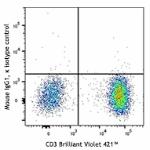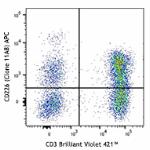- Clone
- 11A8 (See other available formats)
- Regulatory Status
- RUO
- Other Names
- DNAM-1, PTA1, TLiSA1
- Isotype
- Mouse IgG1, κ
- Ave. Rating
- Submit a Review
- Product Citations
- publications

-

Human peripheral blood lymphocytes were stained with CD3 APC and biotinylated CD226 (clone 11A8, left) or biotinylated mouse IgG1, κ isotype control (right), followed by Sav-PE.
| Cat # | Size | Price | Quantity Check Availability | Save | ||
|---|---|---|---|---|---|---|
| 338326 | 100 µg | £182 | ||||
DNAM-1 (CD226) is a ~65 kD glycoprotein expressed on cell surface of T cells, NK cells, monocytes/macrophages, platelets and megakaryocytes and a subset of B cells and a member of the immunoglobulin (Ig)-superfamily containing 2 Ig-like domains of the V-set. The ligands for CD226 are the poliovirus receptor (CD155) and its family member nectin-2 (CD112), which are broadly expressed on epithelial, endothelial and neuronal cells. CD226 is physically associated with LFA-1 in NK cells and activated T cells, and involved in LFA-1-mediated signaling.
Product DetailsProduct Details
- Verified Reactivity
- Human
- Reported Reactivity
- African Green, Baboon, Cynomolgus, Rhesus
- Antibody Type
- Monoclonal
- Host Species
- Mouse
- Formulation
- Phosphate-buffered solution, pH 7.2, containing 0.09% sodium azide.
- Preparation
- The antibody was purified by affinity chromatography and conjugated with biotin under optimal conditions.
- Concentration
- 0.5 mg/ml
- Storage & Handling
- The antibody solution should be stored undiluted between 2°C and 8°C. Do not freeze.
- Application
-
FC - Quality tested
- Recommended Usage
-
Each lot of this antibody is quality control tested by immunofluorescent staining with flow cytometric analysis. For flow cytometric staining, the suggested use of this reagent is ≤ 0.25 µg per million cells in 100 µl volume. It is recommended that the reagent be titrated for optimal performance for each application.
- Application Notes
-
Additional reported applications include: block NK cell-mediated lysis.
-
Application References
(PubMed link indicates BioLegend citation) -
- Fuchs A, et al. 2004. J. Immunol. 172:3994.
- RRID
-
AB_2721495 (BioLegend Cat. No. 338326)
Antigen Details
- Structure
- Ig domain containing adhesion molecule
- Distribution
-
Peripheral blood T cells, NK cells, monocytes/macrophages, platelets and megakaryocytes and a subset of B cells
- Function
- Receptor involved in intercellular adhesion, lymphocyte signaling, cytotoxicity and lymphokine secretion mediated by cytotoxic T-lymphocyte (CTL) and NK cell
- Interaction
- Interacts with LFA-1.
- Ligand/Receptor
- PVR (CD155) and Nectin-2 (CD112)
- Cell Type
- B cells, Macrophages, Megakaryocytes, Monocytes, NK cells, Platelets, T cells
- Biology Area
- Immunology
- Molecular Family
- CD Molecules
- Antigen References
-
1. Shibuya A et al. 1996. Immunity 4:573.
2. Tahara-Hanaoka S et al. 2004. Int. Immunol. 16:533.
3. Pende D et al. 2005. Mol. Immunol. 42:463. - Gene ID
- 10666 View all products for this Gene ID
- UniProt
- View information about CD226 on UniProt.org
Related Pages & Pathways
Pages
Related FAQs
- How many biotin molecules are per antibody structure?
- We don't routinely measure the number of biotins with our antibody products but the number of biotin molecules range from 3-6 molecules per antibody.
Other Formats
View All CD226 Reagents Request Custom Conjugation| Description | Clone | Applications |
|---|---|---|
| Purified anti-human CD226 (DNAM-1) | 11A8 | FC |
| FITC anti-human CD226 (DNAM-1) | 11A8 | FC |
| PE anti-human CD226 (DNAM-1) | 11A8 | FC |
| APC anti-human CD226 (DNAM-1) | 11A8 | FC |
| PerCP/Cyanine5.5 anti-human CD226 (DNAM-1) | 11A8 | FC |
| PE/Cyanine7 anti-human CD226 (DNAM-1) | 11A8 | FC |
| APC/Fire™ 750 anti-human CD226 (DNAM-1) | 11A8 | FC |
| Brilliant Violet 785™ anti-human CD226 (DNAM-1) | 11A8 | FC |
| Brilliant Violet 605™ anti-human CD226 (DNAM-1) | 11A8 | FC |
| PE/Dazzle™ 594 anti-human CD226 (DNAM-1) | 11A8 | FC |
| Biotin anti-human CD226 (DNAM-1) | 11A8 | FC |
| Brilliant Violet 510™ anti-human CD226 (DNAM-1) | 11A8 | FC |
| Alexa Fluor® 647 anti-human CD226 (DNAM-1) | 11A8 | FC |
| Brilliant Violet 421™ anti-human CD226 (DNAM-1) | 11A8 | FC |
| Brilliant Violet 711™ anti-human CD226 (DNAM-1) | 11A8 | FC |
| TotalSeq™-A0368 anti-human CD226 (DNAM-1) | 11A8 | PG |
| TotalSeq™-C0368 anti-human CD226 (DNAM-1) | 11A8 | PG |
| TotalSeq™-B0368 anti-human CD226 (DNAM-1) | 11A8 | PG |
| TotalSeq™-D0368 anti-human CD226 (DNAM-1) | 11A8 | PG |
Compare Data Across All Formats
This data display is provided for general comparisons between formats.
Your actual data may vary due to variations in samples, target cells, instruments and their settings, staining conditions, and other factors.
If you need assistance with selecting the best format contact our expert technical support team.
-
Purified anti-human CD226 (DNAM-1)

Human peripheral blood lymphocytes were stained with CD3 APC... -
FITC anti-human CD226 (DNAM-1)

Human peripheral blood lymphocytes were stained with CD3 APC... -
PE anti-human CD226 (DNAM-1)

Human peripheral blood lymphocytes were stained with CD3 Bri... 
-
APC anti-human CD226 (DNAM-1)

Human peripheral blood lymphocytes were stained with CD3 Bri... 
-
PerCP/Cyanine5.5 anti-human CD226 (DNAM-1)

Human peripheral blood lymphocytes were stained with CD3 Bri... -
PE/Cyanine7 anti-human CD226 (DNAM-1)

Human peripheral blood lymphocytes were stained with CD3 Bri... -
APC/Fire™ 750 anti-human CD226 (DNAM-1)

Human peripheral blood lymphocytes were stained with CD3 Bri... -
Brilliant Violet 785™ anti-human CD226 (DNAM-1)

Human peripheral blood lymphocytes were stained with CD3 FIT... -
Brilliant Violet 605™ anti-human CD226 (DNAM-1)

Human peripheral blood lymphocytes were stained with CD3 FIT... -
PE/Dazzle™ 594 anti-human CD226 (DNAM-1)

Human peripheral blood lymphocytes were stained with CD3 Bri... -
Biotin anti-human CD226 (DNAM-1)

Human peripheral blood lymphocytes were stained with CD3 APC... -
Brilliant Violet 510™ anti-human CD226 (DNAM-1)

Human peripheral blood lymphocytes were stained with CD3 APC... -
Alexa Fluor® 647 anti-human CD226 (DNAM-1)

Human peripheral blood lymphocytes were stained with CD3 FIT... -
Brilliant Violet 421™ anti-human CD226 (DNAM-1)

Human peripheral blood lymphocytes were stained with CD3 APC... -
Brilliant Violet 711™ anti-human CD226 (DNAM-1)

Human peripheral blood lymphocytes were stained with CD3 FIT... -
TotalSeq™-A0368 anti-human CD226 (DNAM-1)
-
TotalSeq™-C0368 anti-human CD226 (DNAM-1)
-
TotalSeq™-B0368 anti-human CD226 (DNAM-1)
-
TotalSeq™-D0368 anti-human CD226 (DNAM-1)
 Login / Register
Login / Register 










Follow Us